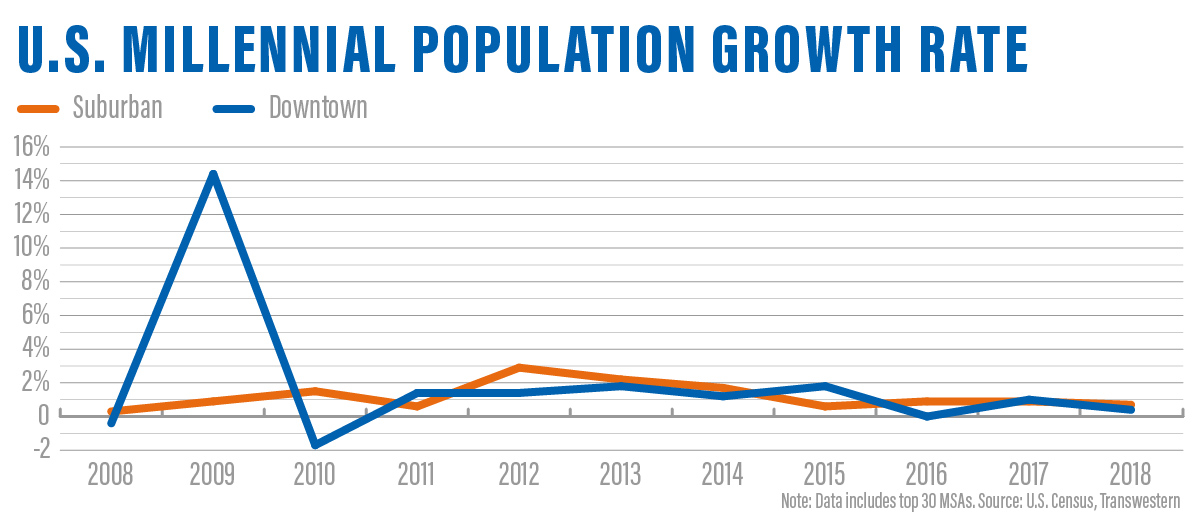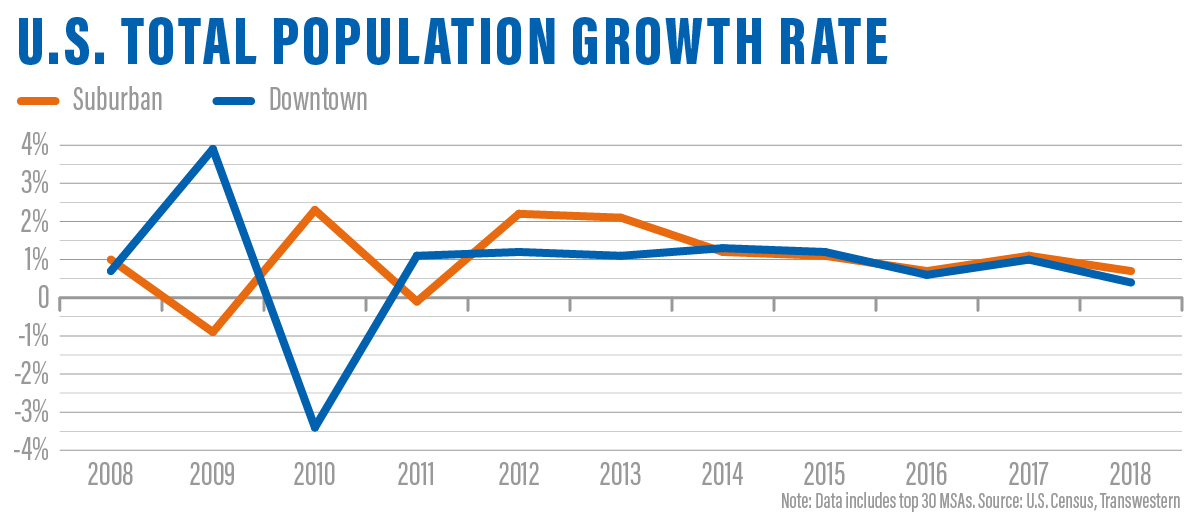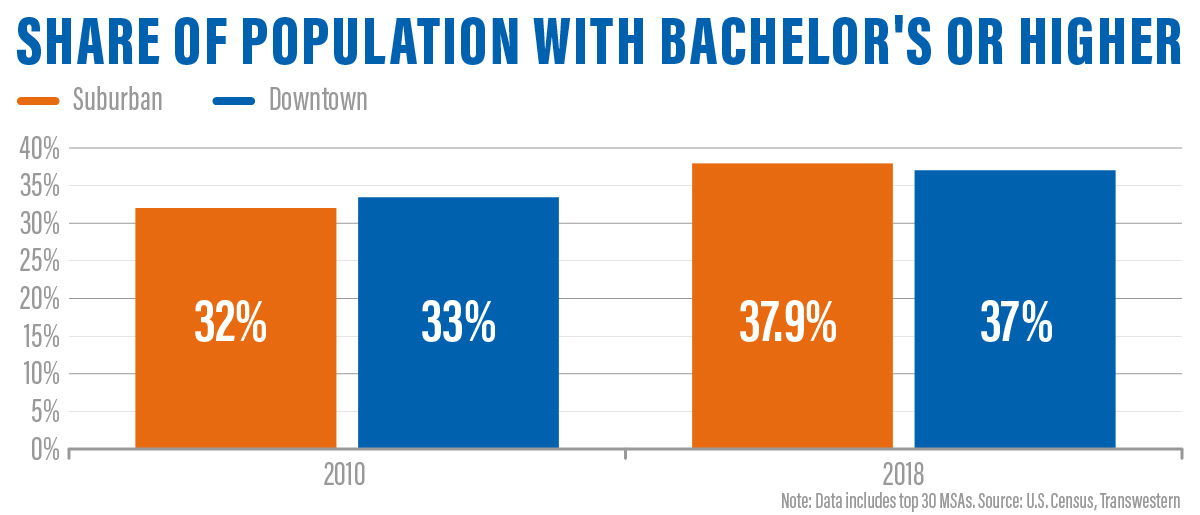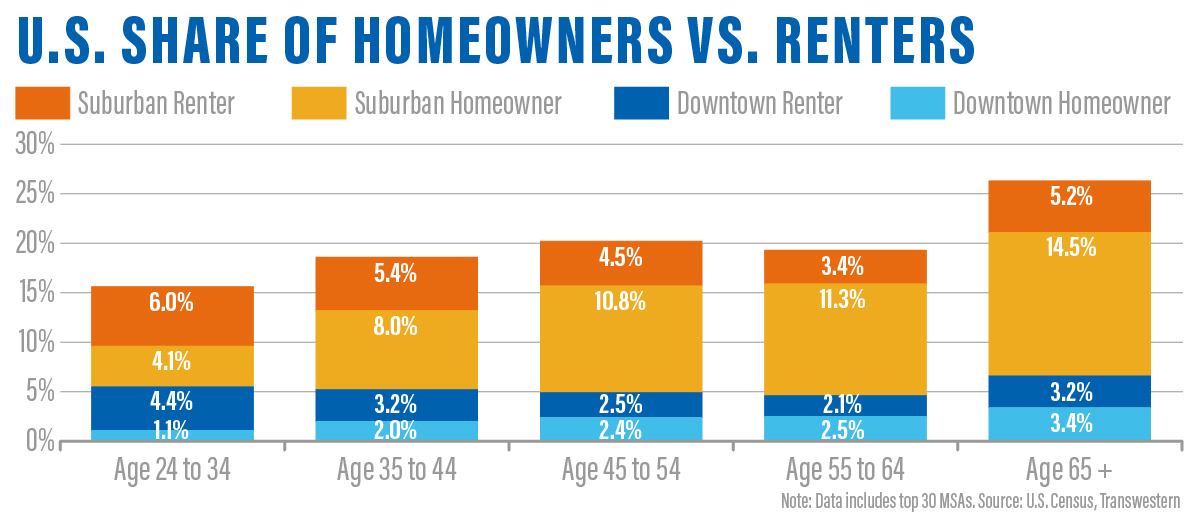In this three-part series, Transwestern examines downtown versus suburban real estate performance of the top 30 U.S. markets post-recession to develop a clearer picture of the resilience exhibited in many suburban areas. Part 1 laid out the historical data to reveal a more complex story than is often told amid assertions about the “death” of suburbia. In Part 2, we focus on historical demographic trends as well as those that will support the strength of the suburbs over the next several years.
_______________________________________________________________________________________________________________________________________________
POPULATION
Suburban markets have prospered demographically over the last several years, and one of the biggest factors is the rise in population. Although the downtown market experienced a surge of millennials in 2009, the rate of growth has since subsided.
For quite a few years, many companies interested in locating downtown have operated under the assumption that the hiring prospects for young, educated professionals are higher. This notion was reinforced with headlines about millennials moving to downtown markets, such as in 2009, when growth surged by 14.4%. Today, however, most millennials – 69%, to be exact – live in the suburbs.
After the influx seen a decade ago, the growth rate of millennials downtown has averaged 0.8% per year since 2010, below the suburban growth rate of 1.3%. This suggests that the trend to relocate downtown, seen at the end of the recession, is beginning to reverse.


TALENT
A qualified workforce goes hand-in-hand with population growth when companies consider sites for a new location, and today’s tight job market has fueled the war for talent.
Although downtown has outpaced the suburbs in its share of the population with a bachelor’s degree or higher, the spread between downtowns and suburbs is slight at only 90 basis points. This means that for most employers, there is sufficient talent in both urban areas and their suburban counterparts. And over the next several years, the suburbs may lead by this measure.

HOMEOWNERSHIP
Are millennials really breaking the cycle established by baby boomers and Generation X? Certainly, select downtown markets remain popular places to call home among this generation, but the overall trend points to a suburban comeback.
Suburbs are likely on the upswing and will remain in favor over the next several years, boosted by older millennials as they move into marriage and family planning and housing affordability becomes a factor. This is important because suburban homebuying by millennials boosts the percentage of qualified talent that desires a short commute to work, giving growing companies more hiring options.
History shows that as people age, they typically follow a path to homeownership, primarily in the suburbs. Only 4.1% of people aged 24 to 34 currently own homes in the suburbs. However, this share rises with the age bracket, growing to 8% for those aged 35 to 44 and 10.8% for those aged 45 to 54. While it is likely the millennial generation will take more time in this transition compared to past generations (as they delay child-rearing and large purchases due to student loans, for example), we expect the path they follow will be fundamentally the same.

THE STORIES BEHIND THE NUMBERS
Historical data and demographic trends paint a promising picture for suburban commercial real estate markets, and in some areas, revival has already taken hold. In Part 3, we’ll feature U.S. suburbs that have benefitted from local investment and renewed tenant interest.
Sandy McDonald is the Director of Market Research for the Midwest region, and Elizabeth Norton is the Managing Research Director for the Mid-Atlantic region.
SEE ALSO:
- Strength of Suburban Real Estate Part 1: Data Tells a Complex Story
- Strength of Suburban Real Estate Part 3: Success Stories
- Cities and Suburbs: The Best of Both Worlds
- Underwriting Real Estate Investment in a Mature Market
RELATED TOPICS:
commercial real estate real estate capital markets us job market us economy economic growth market reports office leasing agency leasing landlord representation office leasing strategy office building repositioning